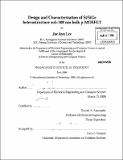Design and characterization of Si/SiGe heterostructure sub-100 nm bulk p-MOSFET
Author(s)
Lee, Jae-kyu, Ph. D. Massachusetts Institute of Technology
DownloadFull printable version (43.72Mb)
Other Contributors
Massachusetts Institute of Technology. Dept. of Electrical Engineering and Computer Science.
Advisor
Dimitri A. Antoniadis.
Terms of use
Metadata
Show full item recordAbstract
As the gate length of CMOS device is scaled down to the sub-100 nanometer node, the development of devices faces many technological challenges, which are related to material and process integration. As a new channel material, compressively strained SiGe layer grown directly on the bulk Si is attractive for the p-MOSFET because of its integration compatibility with the Si-based process. The goal of this thesis is to design and fabricate bulk Si/SiGe heterostructure nano scale p-MOSFETs and characterize their performance. In designing the sub-100 nm Si/SiGe heterostructure devices, low temperature process is necessary because of the high diffusivity of Ge in the strained SiGe layer and shallow source/drain structure. In this work, nickel silicidation is used as a low temperature process for low resistance source/drain and fully silicided (FUSI) gate. E-beam lithography is used for patterning nano scale gate with hydrogen silsequioxane (HSQ) e-beam resist and proper cleaning process for CMOS process compatibility. Extraction of carrier transport parameters for deep submicron devices will be also discussed as a performance indicator for characterizing Si/SiGe heterostructure p-MOSFET with special consideration of strain and defect effects. The degradation of effective mobility and velocity was observed in nano-scale Si/SiGe p-MOSFETs. This is mainly due to the increased coulombic scattering by the increased doping concentration in the channel. The defects and strain relaxation are other two possible mechanisms of mobility degradation. (cont.) For further down scaling and mobility enhancement of p-MOSFETs, an additional uniaxial strain is desirable for SiGe material with careful optimization of the channel doping.
Description
Thesis (Ph. D.)--Massachusetts Institute of Technology, Dept. of Electrical Engineering and Computer Science, 2009. Cataloged from PDF version of thesis. Includes bibliographical references (p. 97-107).
Date issued
2009Department
Massachusetts Institute of Technology. Department of Electrical Engineering and Computer SciencePublisher
Massachusetts Institute of Technology
Keywords
Electrical Engineering and Computer Science.